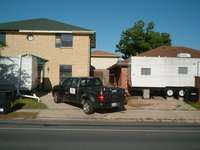Hard to fix the Big Easy

So in April, I volunteered with Continuity Cares to assist for a day in repair and rehabilitation in America's home of gumbo, jazz, Fat Tuesday--and oil refining.
Continuity Cares is the public-spirit inspiration of Bob Nakao of Continuity Insights--a controlled-circulation magazine and genuinely-useful annual BCP conference that I attended a few days earlier--with the sponsorship of French bank BNP Paribas North America and the Sheraton New Orleans hotel.
With about 20 other people, I spent an afternoon at the District 4 firehouse in the Read Boulevard East neighborhood (upper right corner of the map). Here's a short slide show (17 photos).
We scraped, sanded and painted the entire inside of the building, helping its firefighters whose "station" has been a trailer since August, 2005. Many of them have been living in trailers, too, because their homes were destroyed.
%IMAGE=Height_of_flooding.jpg%The firefighter in this picture shows how high the flood waters rose outside the firehouse. Inside, the water was 18 inches (45 cm) deep--for days.
This is only the 12th of New Orleans' 25 fire stations to be repaired. Half of the city's stations are still unusable.
Station Chief Tim McConnell, like everyone I met, was effusively grateful. "It may have only seemed like a quick day for ya'll, but getting the stations done and reoccupied goes much farther by decreasing the mental stress and increasing the moral of the members," he wrote by e-mail.
The police station for this neighborhood is still a trailer, too. Driving through the neighborhood, you understand viscerally that the human impact of a disaster is so much larger--and more lugubrious--than "business impact analysis".
The same day, I spent the morning building bookshelves and stacking new textbooks at the Lake Castle School in the Little Woods neighborhood. Of the 425 plus children now in the school, the families of 95 percent of them lost everything in Katrina--houses, cars, belongings, pets. Here's the slide show (15 slides).
The school was the temporary base for a National Guard contingent in the aftermath of Katrina. After the Guard left, the school's gym became an animal rescue shelter.
When the school's pool could finally be drained, snakes slithered out.
The school is literally across the street from Lake Pontchartrain. Imagine watching Hurricane Katrina approach from a building across the street from the Gulf Coast. It must have been utterly terrifying.
Lake Castle School has been adopted by BNP Paribas, which has donated money, materials and the volunteer labor of its employees. They're serious about it, too: one of the bank's BCP coordinators flew to New Orleans from Paris, France, to volunteer the day I was there. Merci bien, Anne-Marie!
There may be no hospitality like Southern hospitality to make one feel appreciated, but the satisfaction I felt from doing even a little bit to help was simply...sublime.
I wish I could have that feeling more often. I don't get it nearly often enough.